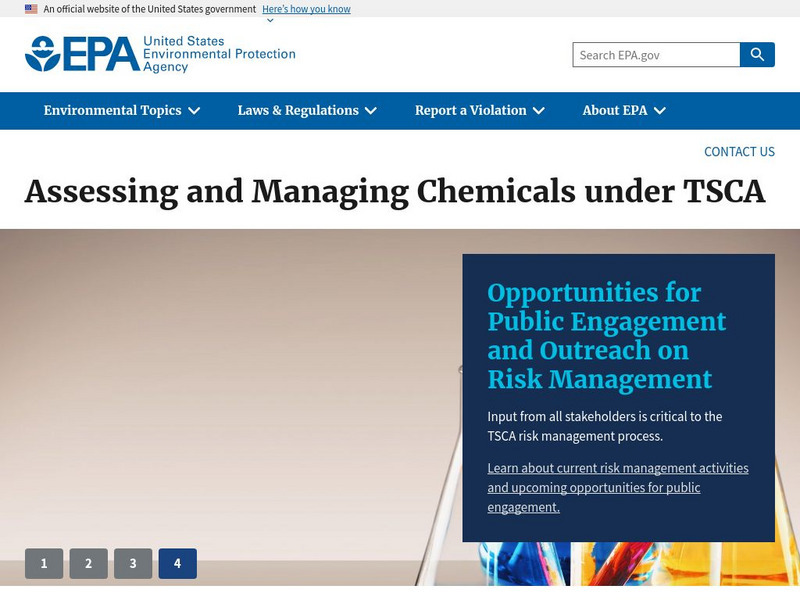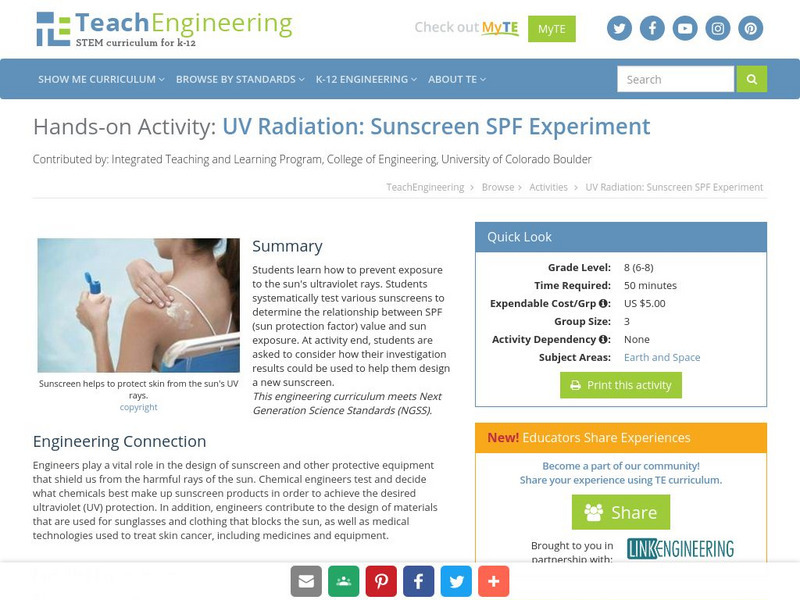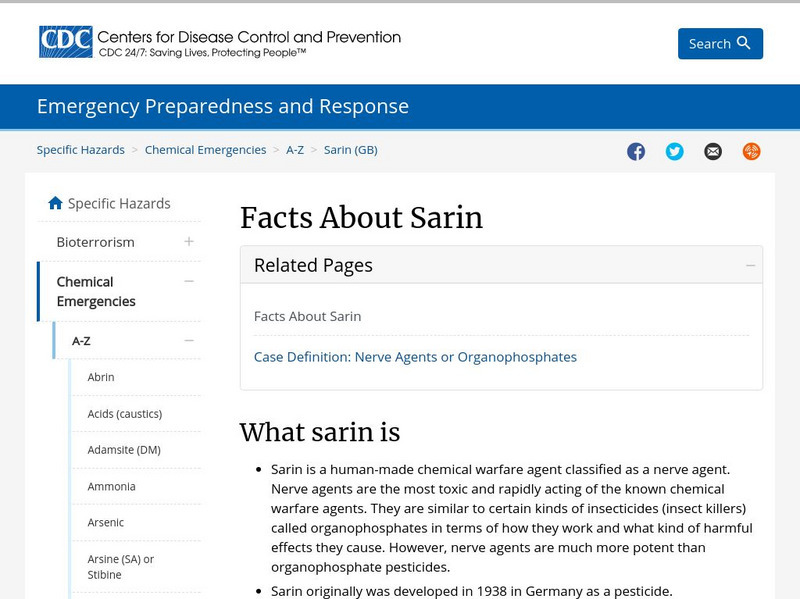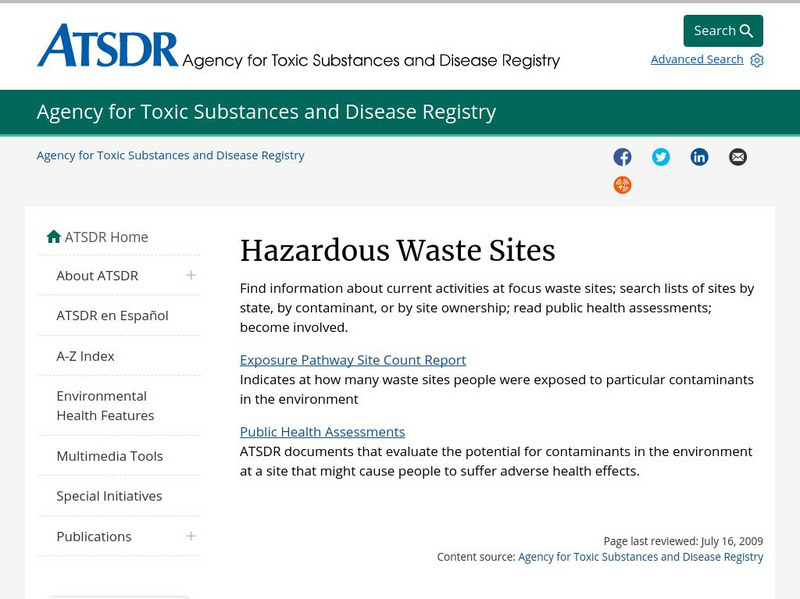Massachusetts Institute of Technology
Mit: Open Course Ware: Chemicals in the Environment: Toxicology and Public Health
A college course featuring instructor's notes and case studies about the relationship between exposure to environmental chemicals and human diseases.
PBS
Now With Bill Moyers: Kids and Chemicals: Facts and Laws
Investigate synthetic chemicals that may be found in one's environment, and consider how toxic synthetic chemicals may affect people differently. Reflect on alternatives to toxic home-use products, and evaluate the risks and benefits.
US Environmental Protection Agency
Epa: Chemicals in the Environment
Information summaries on some chemicals and descriptions of how you might be exposed to these chemicals, how that exposure might affect the environment, etc. Please note that this type of information changes rapidly.
Boston University
Lessons From Love Canal: History: The Start of a Movement
A look at how a group of residents who were affected by the leak of chemicals at Love Canal, banded together to force the New York government, and ultimately the federal governmnent, to take their complaints seriously.
New York State Dept. of Health
New York State Department of Health: Love Canal Public Health Time Bomb
Read the report to the New York governor and legislature from the Commissioner of Health laying out the dangers presented by the toxic chemicals dumped in the town of Love Canal.
University at Buffalo
Love Canal Collections: Niagara Gazette Newspaper Clippings
Newspaper clippings covering many aspects of Love Canal including much information about the litigation and claims filed by those so affected by the pollution that seeped into the town.
Other
Pollution Probe: Mercury in the Environment [Pdf]
High levels of mercury exposure can cause birth defects, permanent brain or kidney damage, and/or death. This resource focuses on the impacts of mercury in the environment. Learn how mercury can reap havoc on lakes and other aquatic...
TED Talks
Ted: Ted Ed: Why Do We Have to Wear Sunscreen?
You already know that a trip to the beach can give you a nasty sunburn, but the nitty gritty of sun safety is actually much more complex. Wrinkle-causing UVA rays and burn-inducing UVB's can pose a serious risk to your health (and good...
Other
Green Facts: Scientific Facts on Dioxins
Dioxins have been found to impose potentially harmful, even fatal effects. Learn about these persistent organic pollutants in this thorough report on dioxin exposure. A summary, details, and cited sources section are provided on this site.
Centers for Disease Control and Prevention
Centers for Disease Control: Atsdr: Beryllium
Information on beryllium and beryllium exposure disease for those who need information due to possible exposure at work.
TeachEngineering
Teach Engineering: It Burns!
In this activity, students learn how to prevent exposure to the Sun's harmful ultraviolet rays. Students will systematically test various sunscreens to determine the relationship between spf (sun protection factor) value and sun...
Centers for Disease Control and Prevention
Centers for Disease Control: Facts About Vx
An overview of VX, a nerve agent and known weapon of chemical warfare. Includes information about the signs and symptoms of VX exposure and recommended treatments.
Centers for Disease Control and Prevention
Centers for Disease Control: Facts About Sarin
An overview of the nerve agent sarin, including signs and symptoms of sarin exposure, ways to protect yourself from exposures, and treatment.
US Environmental Protection Agency
Epa: Assessing Health Risks From Pesticides
This site provides information about the active ingredients registered as pesticides. Site discusses toxicology, exposure, dose-response and risk characterization.
Centers for Disease Control and Prevention
Centers for Disease Control: Facts About Sulfur Mustard
An overview of sulfur mustard, also known as mustard gas. Includes signs and symptoms of, and treatment for exposure to sulfur mustard.
Centers for Disease Control and Prevention
Centers for Disease Control: Facts About Ricin
Information that answers the questions what ricin is, where ricin is found and how it is used, how ricin exposures occur, how ricin affects the body, signs and symptoms of ricin exposure, and the like.
Centers for Disease Control and Prevention
Centers for Disease Control: Facts About Phosgene
Find out about the dangers of the chemical, phosgene, and how people can protect themselves from exposure.
Wikimedia
Wikipedia: Dioxin
Use Wikipedia to explore dioxins. It gives the definition, as well as, sources, health effects, and exposure incidents.
PBS
Pbs Learning Media: Environmental Public Health: Protect Your Health and Environment
Learners learn what they can do to protect themselves from health hazards in their environment. They learn about potential hazards, how these can affect their health, and what they can do to minimize their exposure.
National Institutes of Health
Niehs: Kids' Pages: What's Wrong Whiskers?
Online children's story that teaches about the health effects of exposure to environmental hazards such as chemicals. Click on "next" at the bottom of the story to see why Whiskers, the family cat, becomes ill from all the chemicals used...
Centers for Disease Control and Prevention
Centers for Disease Control: Atsdr: Superfund Hazardous Waste Sites
Extremely detailed look at the dangers associated with the hazardous and solid waste sites in the U.S.
Other
Phosphoric Acid
This Canadian Centre of Occupational Health & Safety site offers links about the specific health effects, safety, proper handling, and first aid of phosphoric acid exposure.
Encyclopedia of Earth
Encyclopedia of Earth: Uranium
Information about the radioactive element, Uranium, atomic number 92. Describes its history, physical and atomic properties, how abundant it is on the Earth, and permissible exposure limits. Also discusses sources, uses, isotopes,...
US Environmental Protection Agency
Epa: Air Toxics Website Nickel
Very detailed information on the chemical element Nickel. Discusses its uses, physical properties, and the potential effects of exposure.




















